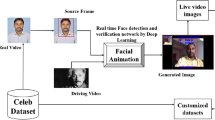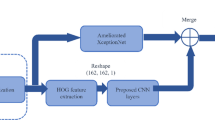Abstract
Nowadays, the surveillance system is an important asset for Crime detection. Hence, many methods were implemented to detect the crime in different ways, such as based on activities, handling tools, facial recognition, etc. In addition, to execute this method, several neural approaches were developed in a different environment; hence the noise content and video image complexity have made the crime detection task difficult. Therefore, to improve crime detection, the present work has aimed to design a novel Whale-based Modular Neural Framework (WbMNF) for attaining the best prediction results. In addition, the crime events were predicted by analyzing the face. Initially, the videos were collected and imported to the system. Hereafter, the training flaws were eliminated in the pre-processing layer. Moreover, the pre-processed data is entered into the classification layer of WbMNF to extract the face feature and to predict the criminals. Hence, the incorporation of whale fitness has provided the finest prediction outcome. Subsequently, the result of the developed technique is compared with state of the art schemes and has earned improved crime detection accuracy than the existing models.












Similar content being viewed by others
Data Availability
Data sharing not applicable to this article as no datasets were generated or analysed during the current study.
References
Abed R, Bahroun S, Zagrouba E (2021) KeyFrame extraction based on face quality measurement and convolutional neural network for efficient face recognition in videos. Multimed Tools Appl 80:23157–23179. https://doi.org/10.1007/s11042-020-09385-5
Adero E, Okeyo G, Mwangi W (2019) A model for visual and intuitive crime investigation based on associative rule mining technique (VICIBARM): a case study of Kenya. 2019 IST-Africa week conference (IST-Africa), pp 1-8. https://doi.org/10.23919/ISTAFRICA.2019.8764876
Ali W, Tian W, Din SU, Iradukunda D, Khan AA (2021) Classical and modern face recognition approaches: a complete review. Multimed Tools Appl 80:4825–4880. https://doi.org/10.1007/s11042-020-09850-1
Al-Obaydy WNI, Suandi SA (2020) Automatic pose normalization for open-set single-sample face recognition in video surveillance. Multimed Tools Appl 79:2897–2915. https://doi.org/10.1007/s11042-019-08414-2
Bernasconi O, Lira E (2019) Making state violence visible: documenting, investigating and denouncing atrocities. Resistance to Political Violence in Latin America, Palgrave Macmillan, Cham, pp 117–160
Ch R, Gadekallu TR, Abidi MH, Al-Ahmari A (2020) Computational system to classify cyber crime offenses using machine learning. Sustainability 12(10):4087. https://doi.org/10.3390/su12104087
Dino HI, Abdulrazzaq MB (2019) Facial expression classification based on SVM, KNN and MLP classifiers. 2019 international conference on advanced science and engineering (ICOASE), IEEE
Felix Enigo VS (2020) An Automated System for Crime Investigation Using Conventional and Machine Learning Approach. In: Raj J, Bashar A, Ramson S (eds) Innovative Data Communication Technologies and Application. ICIDCA 2019. Lecture notes on data engineering and communications technologies, Springer, Cham, vol 46. https://doi.org/10.1007/978-3-030-38040-3_12
González-Lozoya SM, de la Calleja J, Pellegrin L, Escalante HJ, Medina MA, Benitez-Ruiz A (2020) Recognition of facial expressions based on CNN features. Multimed Tools Appl 79(19):13987–14007. https://doi.org/10.1007/s11042-020-08681-4
Gottschalk P (2021) Detecting and investigating environmental crime. The Case of Tjøme Island, Springer International Publishing, pp XI-286. https://doi.org/10.1007/978-3-030-74184-6
Hsu GSJ, Wu HY, Yap MH (2020) A comprehensive study on loss functions for cross-factor face recognition. Proceedings of the IEEE/CVF conference on computer vision and pattern recognition workshops, pp 826-827
Hufnagel S (2019) INTERPOL and international trends and developments in the fight against cultural property crime. The Palgrave Handbook on Art Crime. Palgrave Macmillan, London, pp 89–106
Jain R, Nayyar A, Bachhety S (2020) Factex: a practical approach to crime detection. Data Management, Analytics and Innovation, Springer, Singapore, pp 503–516
Kar NB, Babu KS, Sangaiah AK, Bakshi S (2019) Face expression recognition system based on ripplet transform type II and least square SVM. Multimed Tools Appl 78:4789–4812. https://doi.org/10.1007/s11042-017-5485-0
Kumar V, Rao S, Yu L (2020) Noisy student training using body language dataset improves facial expression recognition. European Conference on Computer Vision, Springer, Cham https://doi.org/10.1007/978-3-030-66415-2_53
Kurshan E, Shen H (2020) Graph computing for financial crime and fraud detection: trends, challenges and outlook. Int J Semant Comput 14(04):565–589
Mauricio FGM, Silva JYR, Talhavini M, Júnior SA, Weber IT (2019) Luminescent sensors for nitroaromatic compound detection: investigation of mechanism and evaluation of suitability of using in screening test in forensics. Microchem J 150:104037. https://doi.org/10.1016/j.microc.2019.104037
Mirjalili S, Lewis A (2016) The whale optimization algorithm. Adv Eng Softw 95:51–67
Nasir M, Dutta P, Nandi A (2021) Fuzzy triangulation signature for detection of change in human emotion from face video image sequence. Multimed Tools Appl 80:31993–32022. https://doi.org/10.1007/s11042-021-11196-1
Oloyede MO, Hancke GP, Myburgh HC (2020) A review on face recognition systems: recent approaches and challenges. Multimed Tools Appl 79:27891–27922. https://doi.org/10.1007/s11042-020-09261-2
Oosterman N (2019) Regional overviews of the policing of art crime in the European Union. The Palgrave Handbook on Art Crime. Palgrave Macmillan, London, pp 213–235
Pavithra R, Suresh KV (2019) Fingerprint image identification for crime detection. 2019 international conference on communication and signal processing (ICCSP), IEEE
Peixoto SA, Vasconcelos FFX, Guimarães MT, Medeiros AG, Rego PAL, Lira Neto AV, de Albuquerque VHC, Rebouças Filho PP (2020) A high-efficiency energy and storage approach for IoT applications of facial recognition. Image Vis Comput 96:103899
HU Qidi, Shu Q, Bai MZE et al (2019) FERCaps: a capsule-based method for face expression recognition from frontal face images. DEStech transactions on environment, energy and earth sciences peems
Rahman RU, Tomar DS (2020) A new web forensic framework for bot crime investigation. Forensic Sci Int Digit Inv 33:300943
Rosenblum D, Unick J, Ciccarone D (2020) The rapidly changing US illicit drug market and the potential for an improved early warning system: evidence from Ohio drug crime labs. Drug Alcohol Depend 208:107779
Sangher KS, Singh A (2019) A Systematic Review–Intrusion Detection Algorithms Optimisation for Network Forensic Analysis and Investigation. 2019 International conference on automation, Computational and Technology Management (ICACTM), IEEE
Sreejith AG, Lansy A, Krishna KSA, Haran VJ, Rakhee M (2020) Crime analysis and prediction using graph mining. In: Ranganathan G, Chen J, Rocha Á (eds) Inventive communication and computational technologies. Lecture notes in networks and systems vol 89. Springer, Singapore. https://doi.org/10.1007/978-981-15-0146-3_65
Sudha TS, Rupa C (2019) Analysis and evaluation of integrated cyber crime offences. 2019 innovations in power and advanced computing technologies (i-PACT), IEEE, vol 1
Sung C-S, Park JY (2021) Design of an intelligent video surveillance system for crime prevention: applying deep learning technology. Multimed tools Appl 1-13
Taha M, Ali A, Lloret J, Gondim PRL, Canovas A (2021) An automated model for the assessment of QoE of adaptive video streaming over wireless networks. Multimed Tools Appl 80:26833–26854. https://doi.org/10.1007/s11042-021-10934-9
Taha M, Canovas A, Lloret J, Ali A (2021) A QoE adaptive management system for high definition video streaming over wireless networks. Telecommun Syst 77(1):63–81. https://doi.org/10.1007/s11235-020-00741-2
Yan Y, Zhang Z, Chen S, Wang H (2020) Low-resolution facial expression recognition: a filter learning perspective. Signal Process 169:107370
Zhu X, Guo K, Fang H, Chen L, Ren S, Hu B (2021) Cross view capture for stereo image super-resolution. IEEE Trans Multimed 24:3074–3086. https://doi.org/10.1109/TMM.2021.3092571
Zhu X, Guo K, Ren S, Hu B, Hu M, Fang H (2021) Lightweight image super-resolution with expectation-maximization attention mechanism. IEEE Trans Circuits Syst Video Technol 32(3):1273–1284. https://doi.org/10.1109/TCSVT.2021.3078436
Zolfi H, Ghorbani H, Ahmadzadegan MH (2019) Investigation and classification of cyber-crimes through IDS and SVM algorithm. 2019 third international conference on I-SMAC (IoT in social, Mobile, analytics and cloud) (I-SMAC), IEEE
Author information
Authors and Affiliations
Corresponding author
Ethics declarations
Conflict of Interest
The authors declare that they have no potential conflict of interest.
Ethical Approval
All applicable institutional and/or national guidelines for the care and use of animals were followed.
Informed Consent
For this type of study formal consent is not required.
Additional information
Publisher’s note
Springer Nature remains neutral with regard to jurisdictional claims in published maps and institutional affiliations.
Rights and permissions
Springer Nature or its licensor (e.g. a society or other partner) holds exclusive rights to this article under a publishing agreement with the author(s) or other rightsholder(s); author self-archiving of the accepted manuscript version of this article is solely governed by the terms of such publishing agreement and applicable law.
About this article
Cite this article
Kumar, K.K., Reddy, H.V. An optimized whale-based modular neural framework to predict crime events. Multimed Tools Appl 82, 30855–30873 (2023). https://doi.org/10.1007/s11042-023-14660-2
Received:
Revised:
Accepted:
Published:
Issue Date:
DOI: https://doi.org/10.1007/s11042-023-14660-2




